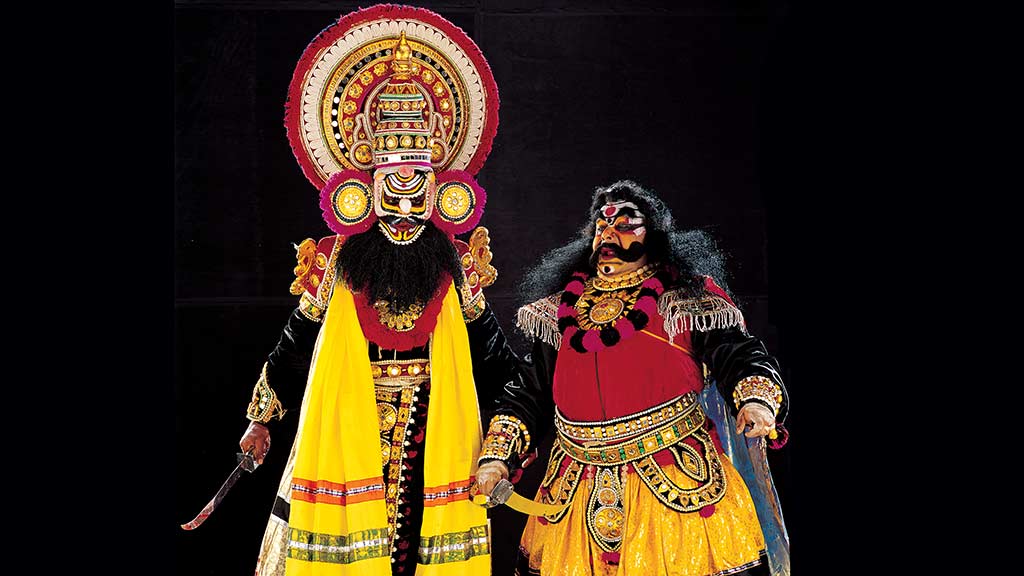
Yakshaganam is an art form performed in South Canara districts of Karnataka and Kasaragod in Kerala. There used to be an ancient form of worship called Bhuta worship practised in these places. Bhuta, which means the past or bygone, refers to the spirit of the ancestors and divine powers. There is a belief that the art form is said to be a manifestation of this Bhuta worship just like Theyyam. As Yakshagana is also influenced by folk dance and Sanskrit drama, it cannot be narrowed down into folk, classical or rural forms since it incorporated elements of all of these. The stories performed in Yakshagana are taken from epics like Ramayana, Mahabharata and Bhagavatham. The word Yakshagana can literally be translated to 'music of celestial beings'. The art form imbibes dance, music and also dialogues. With the accompaniment of background music played using percussion instruments like chenda, maddalam, jagatta or chengila and chakratala or elathalam, the story is narrated by the artists and singers. The performances aren’t always time restrained or fixed to the script but are flexible to improvisations. The dance performance and the dialogues depend on the experience and the skill of the artists. The art form has its own unique stage techniques and the performers sport an elaborate and colourful make-up. The costume consists of a headgear, kavacha, armlets and belts covered with golden foil. The language presented is generally Kannada but is also performed in Malayalam and Tulu languages. It was earlier referred to as Bayatala in some places in Karnataka. Some of the art forms in the neighbouring states like the Therukoothu of Tamil Nadu, Kutiyattam and Chakyarkoothu of Kerala and Veedhinataka of Andhra Pradesh are considered sister art forms of Yakshagana. There's a Yakshagana museum functioning at Manjeshwar Mahakavi Govinda Pai memorial and also a research centre in Government College, Kasaragod. is a ritual folk art form performed in North Kerala since ancient times. It is also known by the name Kaliyattam in some areas. The performance is known as Theyyattam and the elaborate costume is called Theyyakolam. There are over 400 theyyams performed in their own style and music. Some of the prominent ones are Raktha Chamundi, Kari Chamundi, Muchilottu Bhagavathi,Wayanad Kulaven, Gulikan and Pottan. It is a ritualistic performance that combines elements of dance, mime and music. Performances are never conducted on stage but mostly before the village shrines or as ancestor worship in joint-family houses. It honours the beliefs of ancient tribals on worshipping heroes and the spirits of their ancestors. The heavy and elaborate makeup is distinct for each Theyyam. The face painting might take 8 to 10 hours for certain forms as per the traditional rules. The costumes include headgear, ornaments and detailed make-up and the performer dances to the beat of folk instruments like chenda and elathalam, all of which produces a supernatural effect. The duration depends on the significance of the deity being performed and the hierarchy of the shrine and might extend to 12 to 24 hours. Every performance is filled with such energy and grace that the whole premise would seem caught under its spell. The Theyyam season is usually from November to May and begins in Kasaragod and extends to the neighbouring district of Kannur.